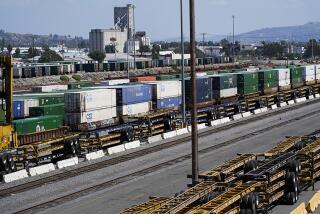UAL Finally Manages a Profit
CHICAGO — United Airlines parent UAL Corp. formally announced Monday its first true quarterly profit since 2000, punctuating a turnaround quarter for U.S. carriers despite record fuel prices.
Like its competitors, UAL benefited from higher fares and more crowded planes as paying customers didn’t flinch in the face of a series of fare increases in the first half of 2006.
The five largest U.S. airline companies to have reported so far posted a collective profit of $1.25 billion in the quarter, led by Southwest Airlines Co.’s $333 million, US Airways Group Inc. with $305 million and American Airlines parent AMR Corp. with $291 million.
Reaffirming the $119-million profit it announced last week, UAL’s earnings for the quarter trailed those three carriers as well as Continental Airlines Inc.’s $198 million. The parent firms of Delta Air Lines Inc. and Northwest Airlines Corp., both restructuring under Chapter 11 bankruptcy protection, have yet to report.
Still, industry consultant John Pincavage said of UAL: “This indicates they’re going in the right direction.”
The same could be said for the recovering airline industry, whose years of painful cost cutting have helped stem the flow of red ink, with a big boost from fare increases that carriers have managed to make stick in a sturdy economy.
“What you’re seeing is the benefits of bankruptcies or threatened bankruptcies, in terms of the concessions they’ve received from labor and creditors,” said Pincavage of Westport, Conn.-based Pincavage & Associates.
“Even without the higher fares, they may have managed to break even or do a little better,” he said. “But I think fares were the icing on the cake.”
As of last week, business fares were up 18% and leisure fares up 9% from a year earlier, according to Harrell Associates, which tracks ticket prices on 280 routes for seven large airlines.
UAL’s income for the April-through-June period amounted to 93 cents a share. That compared with a loss of $1.43 billion, or $12.33, a year earlier when the company was operating under Chapter 11. Revenue grew 16% to $5.11 billion from $4.42 billion.
It was the first quarter in the black for the Elk Grove Village, Ill.-based company since it earned $408 million in the second quarter of 2000.
Packed planes, for both United and other carriers, in part reflect fewer seats available because of the industrywide reduction in capacity that came with cost cutting. United alone took 20% of its fleet out of operation during its three-year bankruptcy makeover, either selling planes or parking them in the desert in the Southwest, and shifted to smaller aircraft on numerous routes.
UAL emerged from Chapter 11 in February.
The nation’s No. 2 carrier reported a $22.9-billion on-paper gain for the first quarter, but that reflected a formal settling of accounts from bankruptcy proceedings and was not a true profit. Excluding those reorganization items, UAL posted a loss of $306 million before reorganization items for that period.
UAL shares declined $1.38, or 5%, to $26.14 as the entire airline sector was pressured Monday by the latest jump in crude oil prices. The stock fell to its lowest close since trading resumed at $43 on Jan. 31.
More to Read
Inside the business of entertainment
The Wide Shot brings you news, analysis and insights on everything from streaming wars to production — and what it all means for the future.
You may occasionally receive promotional content from the Los Angeles Times.










